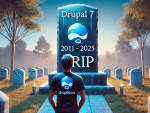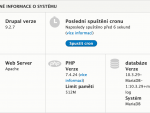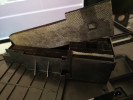If you've been reading my blogs for a long time then you've probably noticed that besides Drupal and WordPress, one of my favorites is the Backdrop content management system. It's based on the incredibly popular Drupal 7.
What is Backdrop?
The Backdrop
content management system is an alternative to Drupal. It's a fork, a derivative that came about when Drupal developers Nate Lampton and Jen Lampton took the version of Drupal 7 current in 2013, took a step aside, and started extending and improving it, while almost preserving the original code structure. In fact, the newer Drupal 8 came with the Twig templating system, components from Symfony, and much more complex development requirements. Not every developer is comfortable with this, and for those who want to stick with the old Drupal concept, there's Backdrop.
At the beginning I was a fan of Backdrop, but I didn't dare to deploy it in production. After all, the community around it isn't as big as Drupal's and if development doesn't continue, it's unnecessarily more of a concern.
Years of development and refinement have shown that Backdrop is reliable. It's a stable system that has already far exceeded the original Drupal 7. It has a visual editor, layout designer and a number of features that Drupal 9 doesn't even have in the core.
Backdrop for web magazine
The first scenario where I used Backdrop in live operation was upgrading a few web magazines from the older Drupal 7. Time was pressing, I didn't know then that Drupal 7 support would be extended several times and I didn't want to end up with an unsupported content management system. So I migrated the sites to Backdrop.
With hindsight, I have to say that I don't miss anything fundamental here and neither do my clients. Preparing the theme layout is no more complicated than it was for Drupal 7. Although, force of habit and familiarity with Twig sometimes makes me lament that some of the editing of the output HTML code is easier to do in modern Drupal. If one knows how.
I really like the insertion of pictures into the text. In the Drupal 7 days I used to do it in two ways. The first was the IMCE module, which simply added a button to the editor to upload a photo. Additionally, if the site had the Image Resize Filter enabled, then all you had to do was drag the image with the mouse, and it would automatically create a corresponding scaled down copy and eventually link to the Lightbox.
The second way of inserting photos into text was with the Insert module. The article had separate fields for images, after uploading each one an Insert button appeared and after selecting one of the prepared sizes this button inserted a preview of the image at the current cursor position in the editor. It was fine, user friendly, and I had control over the destination folder, but for a longer article and a larger number of photos it was cruelly clunky. Just imagine the constant scrolling of the edit form between the editor and the photos.
Backdrop makes inserting photos into text much easier for webmasters. It has a built-in media gallery (similar to WordPress or, with a little effort and configuration, Drupal). Any images can be automatically uploaded straight from your computer or selected from existing images using the gallery. There's no need to set this up in any way like in Drupal 9, where there's also a distinction between file and media.
As for pasting into text, you just press a button in the editor and immediately select from the library. No additional configuration of fields is needed.

When it comes to SEO, there is of course the generation of metatags according to prepared tokens with the possibility of manual editing, generation of appearance maps, alerting search engines to new content using IndexNow. Just like in Drupal.
Backdrop for a simple corporate website
Much more interesting from my point of view are corporate websites built on Backdrop. In this case, I have several implementations of completely new websites, which were then handed over to clients. It must be said that to their satisfaction.
As in Drupal, I use the concept of ready-made page sections inserted into the editor using the Paragraph module. Based on the graphic design, several components are prepared with corresponding fields for filling. We prepare their appearance in CSS, create a few default base pages.
When the web operator then creates new subpages, she/he can choose from any paragraphs, i.e. those ready-made components, and structure the new page exactly according to her/his needs. Almost. Of course, it is not a builder in the sense of Gutenberg or Elementor in WordPress. But it's worked well for me in freelance and agency work to limit my clients a bit and offer them a wider range of components rather than completely arbitrary clicks in the builder.
Thanks to the prepared components, they already know in advance how the page will look like. They don't have to worry about the paralysis of choosing from countless options. They have prepared fields to fill in, they don't forget to add subheadings to images and texts, or perhaps some necessary product characteristics.
The control of the Paragraphs module in Backdrop is almost the same as in Drupal, although there are far fewer additional extensions. But so far, the basics have always been enough for our clients. A plus for Backdrop is the ability to temporarily unpublish and hide paragraphs without deleting them from the page.

I can probably mention two examples. A simpler website built on Backdrop is Student House Brno, which presents accommodation offers. A fresh addition to my portfolio is the website of the Family pub at Sudkovsky Pond. On both of them you can see the use of paragraphs, the components of the individual subpages are repeated in different ways.

Significantly easier maintenance
And why are we deploying Backdrop when it actually does the same thing as Drupal only in a slightly different form? Why Backdrop, when I have no problem at all with the slightly more complex programming and theme creation for Drupal?
It's simple. A huge plus for Backdrop is the ease of maintenance. Much better and easier than it was with Drupal 7. And incomparable to what Drupal 9 asks of a site operator or administrator.
Drupal still can't update its core via administration. Modules can under certain circumstances. When there is a security issue, you have to download the installer, unzip it to your computer and copy it via FTP. At the same time, be careful not to overwrite what you don't want.
Do you find this complicated for the average user? So Drupal 9 built according to best practice requires command line, SSH, using Composer in the command line and then running database updates again via command line and drush, or via administration, where you must not forget about it. When you consider that for the typical site owner, getting FTP access is a problem, you're all set. That some CI/CD comes into play for larger Drupal sites I won't even mention. That's a whole other world.
Of course, for larger and smaller sites, I do the maintenance for the clients when we agree. But even though it's technically not a problem for me, it's still easier for me to press a single button in the administration that updates not only the modules, but also the core content management system. The whole website. And that's exactly what Backdrop offers, while still being "Drupal", not WordPress with its pros and cons. For a small site, you simply don't want to deal with some big deployment.
I'm not knocking Drupal at all. For larger sites it's still a better solution. Bigger ecosystem, bigger community, bigger guarantee.
There would be a few flaws
In order not to praise Backdrop all the time, I have to mention a few shortcomings that real deployment helped me to discover. At the moment, I am most concerned about the problem with converting images to WebP format. The module is there, but it has some installation problem and I couldn't even get it to run manually. For such AVIF then apparently the Backdrop module doesn't even exist.
Multilingual websites. I haven't had the opportunity to use Backdrop for a multilingual site yet, but I would strongly consider it. Because of translations, clients usually want to export data in XLIFF format for a translation agency and then ingest it back. We're out of luck with Backdrop. Although, in Drupal it's not usable in certain combinations of modules either.
There are more modules and options for setting up cache and loading speed in general. For server side and frontend processing. However, even so, a website with Backdrop is able to achieve great results in Lighthouse if the theme is set up properly.
Anyway, despite a few minor problems, Backdrop has a permanent place in my options for building websites. You should try it too. You can run the demo in a few moments without your server.








